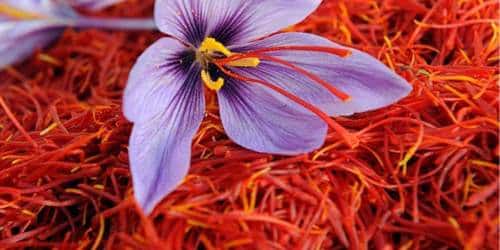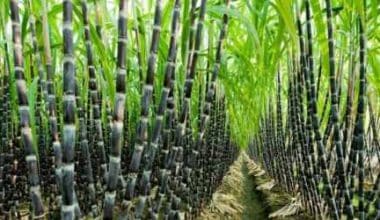Saffron is a spice that is mostly used to season curries, risotto, and fish dishes, but it is also used as a food coloring agent. Because of the number of plants required to harvest a small amount, it is the world’s most costly spice by weight. Saffron is supposed to be indigenous to the Mediterranean and portions of Asia, but it is now widely grown throughout Iran, as well as areas of Spain, France, Italy, and India. This saffron planting guide explains how saffron can be used and grown.
What Is Saffron?
Saffron, the most expensive spice in the world, is a spice obtained from the flower stigmas of the saffron crocus plant, Crocus sativus, an iris family member. The majority of saffron, which is native to Asia Minor, is presently grown in Iran and utilized for culinary uses, as well as medicinal, colors, and perfumes. Saffron is grown in the United States, primarily in Pennsylvania.
All About Saffron Crocus
The world-famous saffron crocus is by far the most expensive spice. It is famous not just for its bright red color, but also for its scarcity. With 220,000 blossoms required to produce a single kg of dried spice, this spice requires multiple fields to produce a crop worth selling.
Crocus sativus was traditionally used in Middle Eastern, Indian, Greek, and Spanish cookery, but it has subsequently been integrated into cuisines all across the world. The plant is thought to have originated in Minoan-era Crete and now thrives in other temperate places across the world. On farms, in gardens, or in containers, saffron can be grown. Crocus saffron is adaptable to a wide range of growth environments.
Read Also: Tomato Farming In Nigeria: Step-by-Step Guide
The saffron crocus is a tiny, stubby flower with a purple cup-shaped bloom in lovely jewel tones. The leaves or foliage are more like green spikes that resemble pine needles, and the entire plant matures to be 4 inches tall. The plant has three stigmas in the middle, and this is the part of the plant that is known as saffron. It’s a vibrant red-orange tri-pronged thread that emerges from the base. It is astonishingly bright and quite visible. Each bulb produces only one flower, but each bulb reproduces as it enters its dormant season during the summer.
The saffron life cycle can be divided into five parts. After sowing in late fall to early winter, saffron crocus bulbs blossom 6-8 weeks later. It blooms and grows leaves before entering hibernation and beginning to produce daughter corms.
How Saffron Plants can be Grown and Cared for
It’s simple to grow your own saffron crocus bulbs, and the crimson stigmas offer a high output of pricey saffron spice. It is best to start growing the bulbs in late summer or early fall. The precise time will be determined by your growing zone. Plant them in August if you live in USDA zones 3-6, and September if you live in USDA zones 7-10.
Plant saffron corms 4 inches deep and 4 inches apart, however a little closer together for a more dramatic look won’t hurt. Some people can even grow 12 plants per square foot. Plant the bulb pointed end down in the planting hole. Plant and care for saffron in your home garden by following these guidelines.
#1. Care
Saffron crocus bulbs are rather simple to grow. This colorful spice is perfect for beginners and a sturdy corm that will come back year after year in the herb garden. There are only a few things to follow to ensure that these little fellas grow properly.
#2. Sun and Temperature
Most gardeners who want to learn how to cultivate saffron crocus will discover that saffron is easily grown in their conditions. While not everyone will be able to produce saffron and leave the corms in the ground all year, most will discover that with a few modifications, these plants will thrive in practically any place. How does that sound? The saffron crocus grows well in temperate climates and is hardy in zones 6-10. At the end of October, it requires a full day of sun (at least 8 hours) and consistent warmth.
Growers should monitor the temperature once the stigmas have been collected. Winters in zones below USDA zone 6 are too cold for corms to overwinter in the ground. To preserve the bulbs from extreme cold, lift and store them throughout the winter. In zones 8-10, you’ll need to bring in the saffron crocus bulbs and artificially ‘winterize’ them so they know when to sprout the next season.
#3. Water and Humidity
It’s lovely to see a crocus in bloom in the landscape. However, don’t overwater these lovely and sturdy small saffron blooms. Saffron crocuses only require a moderate quantity of water in the days preceding harvest, roughly 1/2 inch every week from planting until harvest. Stop watering after the saffron has been picked. This will urge the crocus to finish its life cycle and die.
When watering, utilize a drip irrigation hose to wet your produce evenly. Watering or using a powerful hose might cause damage to these fall-blooming plants.
#4. Soil
Saffron crocuses are hardy plants that thrive in sandy to loamy soils. They can also be grown in poor soil if treated with compost or bone meal. The only condition is that the soil be well-drained. Rot is one of the few issues that can impair the lovely saffron spice if the soil holds too much water.
#5. Fertilizing
This fall-blooming flower is low-maintenance for gardeners interested in learning how to grow saffron. The saffron blossoms do not require much fertilization. If you are amending poor soil or fertilizing overwintered in-ground corms, spread 1 inch of compost over the land where the crocus corms were planted. Alternatively, you can modify the soil with a bone meal before planting. Given the plant’s rapid bloom time and the small crop size, very little is required for these bulbs to yield.
#6. Pruning
A saffron crocus is only clipped when it is harvested. Gently detach the flower from the stalk and the petals from the stigma with sharp scissors or your fingertips. Keep the foliage to allow the bulbs to gradually develop daughter bulbs as they enter hibernation.
#7. Propagation
The saffron crocus is only propagated by allowing each corm to go through its whole life cycle. After harvesting the saffron flowers, the leaves must be allowed to die back. During this stage, ‘daughter’ bulbs emerge. If preferred, dig up these young corms and save the healthiest for next year’s growth, or cover with mulch and let them till the following fall if your climate allows.
How to Harvest and Store Saffron
Picking and storing saffron requires some labor. This is why the spice is so expensive, despite the fact that it is a relatively simple plant to grow. This amazing plant’s vivid red stigmas are a lovely and eye-catching sight, and they easily notify us when they’re ready to be plucked. Some good processes are:
#1. Harvesting
The harvesting window for saffron crocus is quite limited. You should ideally visit your garden in the middle of the day, during the harvest window. Saffron is best gathered early in the morning on a dry day before the sun begins to beat down on the blossom. This occurs approximately 6-8 weeks after the corms are sown. Pick the flower when the bloom is only partly open. Snip off the bottom of the blossom without removing any of the foliage. To begin, open the flower, allowing all of the pieces to fall onto a table or napkin, and gently pluck off the stigma with your fingers or tweezers.
#2. Storing
Saffron threads are delicate; they can’t be exposed to too much sunlight before their quality degrades. After plucking them, store them immediately indoors in a shaded area.
Saffron threads can be utilized shortly after harvesting (within 24 hours) or dried for long-term storage. When it comes to drying, there are two options. Try drying a small crop on a paper towel on a shady table or shelf. They should be dry in three days. If using a dehydrator, distribute the threads evenly on a dehydrator sheet and dehydrate at 45 degrees for 3 hours.
After drying, place the stigmas in an airtight container in a dry place. To store the stigmas for a long time, cover them in foil or another light-blocking material, as sunshine affects the quality of this spice. Commercial vendors use black material to protect themselves from the sun.
Don’t be surprised if your saffron loses a lot of weight! The dehydration process removes 90% of the stigma’s weight!
Troubleshooting Shaffron Plant
Fortunately for saffron crocus growers, these bulbs have few predators and few growing issues. Aside from the hungry rabbit or gopher, this resilient tiny bulb is occasionally afflicted by rot or mites, but only infrequently. Some things to keep an eye out for are:
#1. Growing Problems
Growing saffron crocus is a relatively simple task! This plant is endowed with few growing issues. However, if growing in areas other than its native Greece, it is critical to consider your growth area. It grows best in USDA zones 5-8; while it can grow in zones 9-10, don’t plant it too early because it needs chilly temps to flower. If it gets too hot, the corm may only produce leaves and no flowers.
#2. Pests
Small animals are the most common pests of the saffron crocus. The saffron plant’s bulb is a delicious source of nutrition that may be dug up and eaten by a variety of creatures including rabbits, gophers, voles, and mice. During the winter months, when food is limited, these corms are especially vulnerable to attack.
The saffron bulb mite is a little beetle-like creature that causes the plant to grow in a stunted fashion. The flowers will become shorter and the leaves will become thinner. It’s better to avoid it because the short-lived plants can’t be fully treated once the disease appears, but you can try treating the corms with miticide before planting.
#3. Diseases
While gardeners are lucky to be free of many illnesses, corm rot is a serious worry for those who have soil that holds too much water. Corm rot is a catch-all name for a variety of fungal infections, including Rhizopus, Aspergillus, Penicillium, and Fusarium. They all express themselves by decaying the plant’s bulb and foliage, turning them yellow or brown in appearance. Similar to root rot, these rots can be avoided by planting in well-draining soil and limiting watering.
Where Does Saffron Grow Best?
Saffron is supposed to be indigenous to the Mediterranean and portions of Asia, but it is now widely grown throughout Iran, as well as areas of Spain, France, Italy, and India. The stigmas of the saffron crocus, Crocus sativus, are used to make saffron threads.
Which Country is the Largest Producer of Saffron?
Iran is the world’s greatest producer of saffron, accounting for more than 90% of global production. The Khorasan Razavi province and Gonabad region are located in central Iran and have arid and semiarid weather.
Why is Saffron so Expensive?
Because only a little portion of the bloom is used, one pound of saffron spice requires 75,000 saffron flowers. Because of the limited amount of saffron spice per plant, as well as the fact that harvesting must be done manually, saffron is quite expensive.
How Much Does Saffron Cost?
Saffron is commonly referred to as “red gold,” and for good reason: it is the world’s most costly spice, costing anything from $10 to $20 per gram.
How Much is 1g of Saffron?
One gram of saffron threads is around one tablespoon loosely packed. A pinch of saffron threads (a heaping 1/4 teaspoon) is all you need for a paella that feeds four.
To Sum It Up
Finally, the Saffron farming company represents a potential economic opportunity for farmers all around the world. With rising global demand for saffron and Nigeria’s excellent temperature and soil for saffron growing, it is apparent that the saffron farming sector in the region has considerable potential. Saffron’s health benefits make it a prized commodity in the global market, attracting high prices.
Related Articles
- GREEN ENERGY COMPANIES: 15 Best Green Energy Companies To Invest in The UK
- Banana Farming in Nigeria: Everything You Need To Know
- New Orleans Saints Logo: What Does it Stand For?
- Onion Farming in Nigeria: All You Need To Know
- HARVEST TIME TRACKER: Harvest Software Reviews & Pricing 2023






